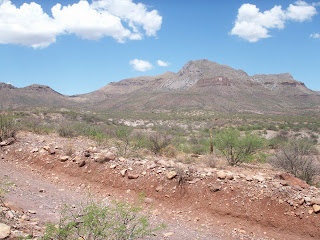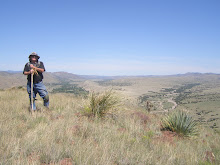One of my stalwart supporters, Kevin, from Dallas, is coming this week (of 12 October). We did a trip out here where we "hiked Apacheria" four or five times in March. We'll keep closer to the Silver City area for the amount of Kevin's time here I can be a part of. That ends on 17 October for me. At any rate, I hope to sum up the trip Brian Huberman & I made to Mexico in the summer. We prefer to not provide any logistical or personal information as we'd like to return & explore more deeply what the Mexican Apacheria means in real, 21st Century terms.
It's clear to me that because Mexico off road is still pretty much the same as it was when the last Apaches were exiled to Florida in 1886, it's a different experience hiking there. I truly want to hike down there. It's clear, though, that it's not possible to do that without feeling like I'm back in Vietnam. This is because the cartels control many remote parts of the country as well as huge urban populations.
The few locals we met are certain Calderon's policies will not be vindicated in the 2012 election.
They believe many Mexicans will BLAME Calderon for all the violence, since he's so heavily pushed a non-traditional Mexican approach to corruption &; crime: unremitting confrontation. Calderon's a PAN candidate and the clearly, in many Mexican voters eyes, has rocked the boat too aggressively.
http://en.wikipedia.org/wiki/Felipe_Calder%C3%B3n
http://en.wikipedia.org/wiki/Institutional_Revolutionary_Party
The PRI has held control of Mexican politics for some time.
I'd try & find some Mexican newspapers that may be in English so that I can begin to gather information
on the PRI's chances for sweeping the national offices. If my friends are correctly, they think Mexican voters want the government to go after the peso power the cartels have ... & not be so aggressive on the people within the drug trade.
My guess is: the U.S.A. is seen as the big lumbering giant it always has been to Mexico, but that the giant has a serious addiction to drugs problem that has caused or led to massive slaughter in the streets & countryside by cartelistas & "sicarios," (i.e., "hit men" or "thugs"). One friend told me lately that in a certain part of a rural Mexican area of Chihuahua, La Linea, the enforcers, have spread the word they're coming to that area to probably kill members of rival cartels.
Take a look @ Googleearth.com
as I have, and just "fly over" Mexico. There are enormous areas where the countryside is remote, backward looking in terms of small villages & towns scattered in rugged mountain or desert areas. There must be enormous fields of marijuana growing. My friend who lives south of Casas Grandes, tells me that this part of Mexico (Chihuahua but
closer to Sonora
http://en.wikipedia.org/wiki/Sonora
than Coauhila, Durango, etc.,
http://en.wikipedia.org/wiki/Coahuila
http://en.wikipedia.org/wiki/Durango
has seen escalating presence of cartel people in the last two years. She & other Americans living there have
left the area.
I would guess that the election will see a reversion to the PRI in many places, probably the national government. While the U.S. will do what it can to ensure a continuation of Calderon's policies, if my friends are right, the indicators say they will not flow seamlessly forward. I suspect accommodations will be suggested to legitimize at least marijuana in some way. Mexico could easily just declare marijuana legal & force the U.S. to do something about it.
One wonders what would happen ... would millions of Notre Americanos head south to live where they can legally smoke dope all the time?
Mexican cartels are clearly fostering marijuana growth INSIDE the U.S., @ national parks and forests.
They mean to muscle out American marijuana growers, I'm sure, & that could escalate violence here, in the U.S. Perhaps American military units, leaving Iraq & Afghanistan, will begin patrolling our parks & forests and BLM lands. There would be some significant high-tech technology brought to bear against Mexican cartel marijuana growers north of the Border.
With gridlock in the States, Comprehensive Immigration Reform seems impossible to believe will happen. Only if President Obama wins re-election can there be any hope of that happening.
If he wins, it will be because he promises comprehensive reform's possible passage under a Democrat President & perhaps, Democrat House of Representatives, w/enough Senate Democrats to move legislation forward.
In the meantime, here are some photos of our trip to Mexico & also, of the Peloncillos as well as photos take @ the Arizona Historical Society's Geronimo exhibit.
The following book is well worth the read:
http://www.amazon.com/Mexico-Narco-Violence-George-W-Grayson/dp/1412811511/ref=sr_1_1?ie=UTF8&qid=1318253982&sr=8-1
It's by George Grayson, and is titled: Mexico: Narco Violence and Failed State.
Grayson's described in detail the various drug cartels that perpetrate violence & mayhem on the Mexican
people. I know that were it possible, I'd be down in Mexico, searching with Mexican Apache aficionados for places the Apache were during the last 25 years of their existence as semi-nomadic peoples. But, those days may have disappeared for me, due to the horrific violence underway.
A few more photos:
This photo is a close up of the Apache scouts @ Cañon de los Embudos. It shows a close up of the Scout, Mule Skinner, translator, cowboy, Tom Horn. Tom Horn is the central character in the last film Steve McQueen starred in. Tom was from Missouri, and according to some, a sociopathic killer. He certainly later became a "regulator" (see the film "Tom Horn," but also, "Missouri Breaks" w/Jack Nicholson, Harry Dean Stanton, Randy Quaid & a chubby Marlon Brando). "Regulators" were paid to kill or drive off "sod-busters" ... i.e., small time farmers who threatened to break up the "Open Range," which is another excellent western with
Robert Duvall, Kevin Costner & Annette Benning.
Geronimo's death certificate. He had been in to the nearest town to Ft. Sill, and got drunk. He
either fell off his horse, and lay all night near the railroad tracks, or got off his horse to urinate, then lay down and spent the night out in the elements. It might have rained on him. In his eighties, he contracted pneumonia and died of complications.
The exaggerations & poor scholarship on the part of local Apaches has shown up in the otherwise excellent series of exhibits @ the Silver City Museum. A local Apache perpetuates the myth that the Chiricahuas who were shipped east, to Ft. Marion (St. Augustine) or Ft. Pickens (Pensacola) Florida,
were shipped east in boxcars.
The image above showed the Geronimo contingent of Chiricahuas beside the train tracks that took them east, but also, with Pullman cars in the background. There's no boxcars in the background because the
Apaches (including the larger contingent of Apaches including: Loco; Lozen; Chihuahua; Olsanny; all Army scouts who assisted in finding Geronimo, etc.) were shipped east from either Hollbrook, Arizona, or Bowie, Arizona ... were all assigned to Pullman cars.
To prevent Apaches such as Massai from jumping the train & returning to New Mexico or Arizona, the Army did nail the windows shut en route to Florida. It mad for close, stifling & unhealthy conditions for the
Apaches as they went east. They weren't used to toilets or any means of relieving themselves on a moving train. They also had difficulty eating the American Army food en route.
But ... they certainly weren't shipped in boxcars.





























